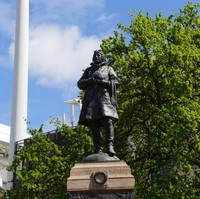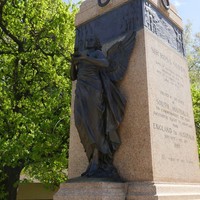Thing
ContributeThe Sir Ross Smith Memorial commemorates the achievements of aviator Sir Ross Smith and the first flight from England to Australia. The monument was unveiled at Creswell Gardens on 10 December 1927 by Lieutenant-Governor Sir George Murray. The statue itself is made from bronze sculptured in the image of Sir Ross Smith dressed in his flying gear. He stands high up on an obelisk with a globe of the world underneath his feet. One foot rests in Europe and the other in Australia to symbolise his famous flight. Below he is accompanied by two female bronze angels, one holding an aeroplane to represent flight and the other wearing a winged helmet to represent fearlessness. The obelisk is decorated with bronze plates depicting the events that took place during the voyage from England to Australia.
Ross Smith, The Aviator
The arrival of Ross Smith, his brother Keith Smith and mechanics James Bennett and Wally Shiers in Darwin, Australia on the 10 December 1919 was greeted with ecstatic admiration. The early twentieth century was a period of great interest in the developing technology of aviation and consequently, the high esteem for Australian pilots had escalated dramatically. The famous 'air race challenge' was a competition for Australian aviators to fly from London to Australia in thirty days or less. Upon completing the challenge in twenty-eight days, Ross and Keith were knighted within two weeks of their arrival in Australia with their deeds recognised internationally. The Australian Government awarded the four men with £10 000 as their prize. It was an incredible achievement which demonstrated the fearlessness and navigation skills of the pilots. Only one other contestant of the challenge reached Australia with the race proving fatal to two crews.
Ross Smith was an inspiration to young Australians of the period. He received his education at Queen’s College in North Adelaide and was an excellent horse rider, a skill he learned on Mutooroo Station, near Cockburn, South Australia, where his father worked. His sense of leadership and military prowess made him a perfect candidate to represent Australia at Gallipoli. He was transferred from the1st Light Horse Brigade 1st Machine Gun Squadron to No 1 Squadron Australian Flying Corps on 24 Oct 1916. By 1917 he was serving as a pilot. A Vickers-Vimy aircraft which was too late to see service in the Great War was used in the race, equipped with extra fuel tankage.
Preparation of the Memorial
Ross Smith and Jim Bennet were tragically killed during a test flight in England on 13 April 1922 in preparation for a round-the-world trip. Keith Smith fortunately had missed the test flight.
A verdict of misadventure was returned (Daily Herald, 17 April 1922).
Back in Adelaide a ‘shilling fund’ was established with a committee to raise money for a memorial. The funds grew rapidly with £1500 collected within weeks.
The suggestion to erect a column or some such outstanding monument at Mount Lofty Summit as a memorial to our beloved gallant airman must commend itself to all (The Register, 8 September 1922).
There was extensive debate over the memorial's location, suggestions included a tower at Mount Lofty which was to double as a navigation beacon for interstate flights. However it was decided that a fitting site for the Ross Smith memorial would be at Creswell Gardens, a site at which Smith himself had advocated the construction of a monument for the Third Light Horse Brigade. By the end of 1923, enough funds had been collected and the memorial committee opened a competition to sculptors from England and Australia to design the statue. The prize was won by Frederick Brook Hitch in his attempts to capture Ross Smith's passion for flying in his work.
The Unveiling of the Memorial
The unveiling of the memorial occurred on 10 December 1927. The event was well attended as everyone paid tribute to the respected hero who had come to symbolise Australian fervour for the ever-growing development of anything aeronautical. The unveiling was accompanied by three aeroplanes circling overhead.
The hum of the engines while the speeches were being delivered sounded like a requiem in a kind of music with which the fallen hero had been so familiar (Border Watch, 13 December 1927).
A speech was given by the Governor Sir George Murray who claimed the memorial was 'a fitting tribute to South Australia’s most famous son'. The ninetieth anniversary of the arrival of Sir Keith and Sir Ross Smith into Darwin in 1919 was commemorated with a service at the statue in Creswell Gardens on 13 December 2009 at 11am. The commemoration also observed the ninetieth anniversary of the England to Australia Air Race which commenced in the same year, 1919. The ceremony was organised by The Return and Service League and the Queens Old College Boys Association (where the Smith brothers attended college in 1902).
Media
Add mediaImages

Image Courtesy of Australian War Memorial, War Collection, P03631.013, Public Domain.








Comments
CommentAdd new comment
Hi Justine, you're still in time for the anniversary, you can follow along the timeline of the flight here: https://epicflightcentenary.com.au/
Hi, I live on the corner of Keith and Smith street in Victoria. Just next to Ross street in Alphington all named after the pilots. There is also a Bennett and Shiers street named after the crew. Wish I'd known about the anniversary cause I would've put some balloons up in honour.
Hi Susan,
There's a committee working on commemoration activities for the anniversary, I'll pass on your comments. One of the things they will be doing is putting up a website which will include more information. I'll share the link here when that is live.
Hi Shane, read your comment. I did not find out about our connection to Ross and Keith and Colin until just before grandpa died in 1992. He was,nt much on family past history. He had one of Keith Smith's flying coats under his Bedford van to catch the oil, it was half eaten by rats but I still wish I had picked it up. His mother Jessie was a Smith and the family is littered with Ross's and Keith's and Colins. So I have to memorabilia, but I have decided, since next November 2019 will mark the 100th anniversary of their flight I am going to try and get the Vickers Vimy moved. It is buried in the back of the old section of Adelaide Airport. Our previous state government, when it built the new part didn't make any provisions for the little plane which is shameful, so I'm hoping to get support to try and get this changed. It won't be easy, but politicians like good news things that make them look credible to voters, so it's worth a try.
Cheers
Susan Laundy
Mylor
SA
My great grandmother Jessie Smith was a cousin of Ross and Keith, and Colin.
My grandfather didn't talk much about family history, only his parents and brothers and sister who I knew well. There is a strong connection to the west.
I only found out about our aviation connection not long before grandpa died.
As next year will mark the 100th anniversary of their amazing flight, I have decided to try and get the Vickers Vimy moved from it's dingy spot at the back of Adelaide airport to a much more appropriate position so more younger people will know the story. I would also love to try and make any connections with family.
Hope we can get something positive going
Susan
Mylor
SA
Thanks for sharing Bill, certainly a remarkable family history.
My father was one of several cousins of Ross and Keith (and the forgotten Colin). Jessie Macpherson had three sisters and four brothers, most of whom remained in WA. I've incorporated what I know about the three brothers in my family history but I don't expect I have anything you don't know already. I'm very pleased that someone is interested enough in the brothers to amass a record of their achievements. I have cousins even in Canada who are anticipating the 2019 celebrations.
Hi Shane, I've sent you a message on the History Trust Facebook page where you also posted. Our curators will be in touch.
Hello
My name is shane Williams
Im from the northern rivers nsw . I have over years amassed a large collection of sir Keith and ross smith item . I have Keith’s flight coat his military buttons silver tobacco tin and many many more items original flight covers and many anniversary items . well they sit in my hallway .and well next year is the 100th birthday of their flight . well I am emailing you and aus post and a few other museum to see who would like to use my display . early so plans can be made for the items to be housed and displayed . would your group have a interest
Shane Williams
Good point Daren and I don't think the author intended it to carry that meaning, we'll edit it to read more positively.
Why is this flight "infamous".
Surely that conjures up images of something sinister,.
This was a triumphant journey and should be celebrated that way.